Page 456 of 520
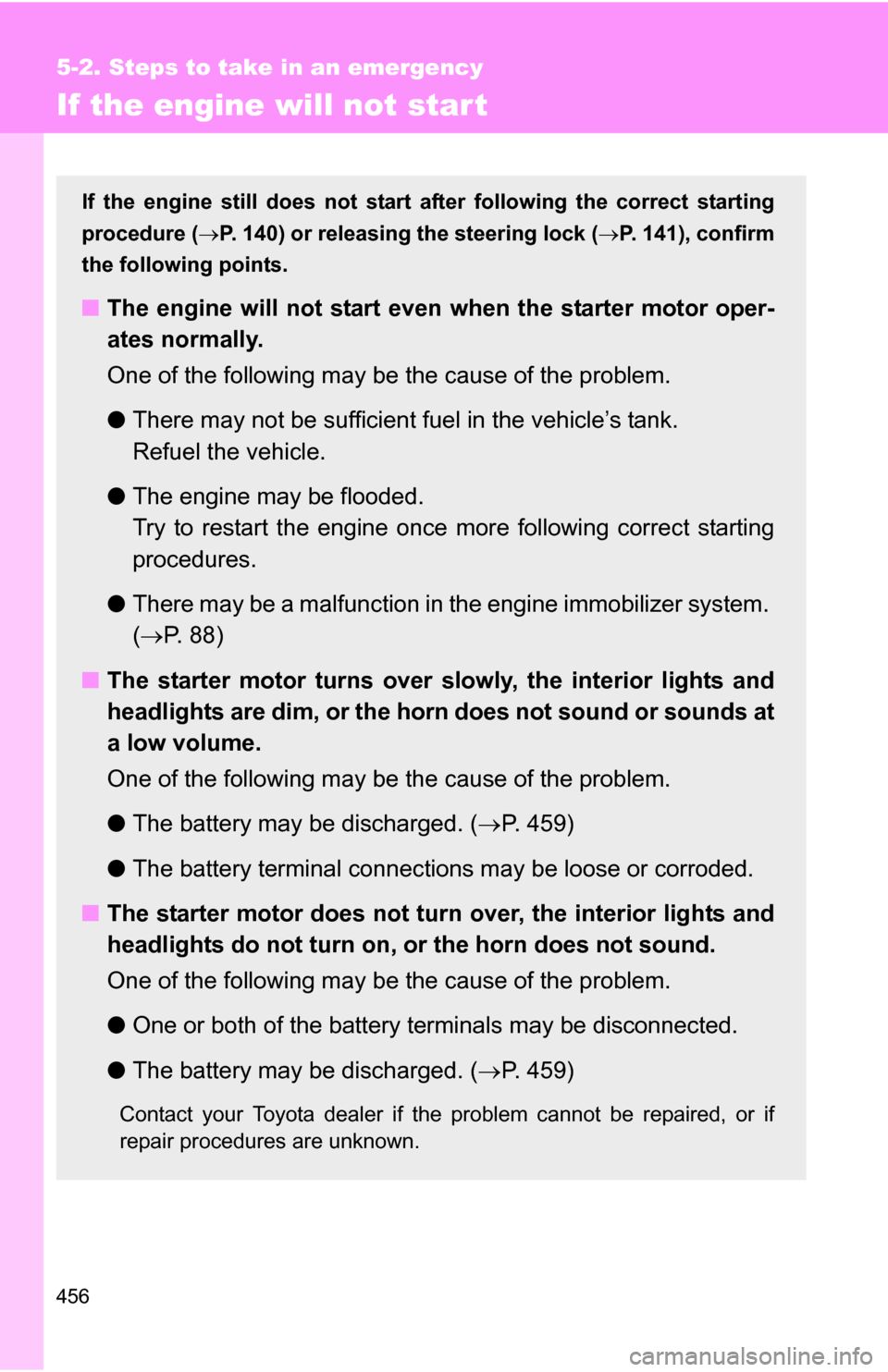
456
5-2. Steps to take in an emergency
If the engine will not star t
If the engine still does not start after following the correct starting
procedure ( P. 140) or releasing the steering lock (P. 141), confirm
the following points.
■ The engine will not start even when the starter motor oper-
ates normally.
One of the following may be the cause of the problem.
●There may not be sufficient fuel in the vehicle’s tank.
Refuel the vehicle.
● The engine may be flooded.
Try to restart the engine once more following correct starting
procedures.
● There may be a malfunction in the engine immobilizer system.
( P. 8 8 )
■ The starter motor turns over slowly, the interior lights and
headlights are dim, or the horn does not sound or sounds at
a low volume.
One of the following may be the cause of the problem.
●The battery may be discharged. ( P. 459)
● The battery terminal connec tions may be loose or corroded.
■ The starter motor does not turn over, the interior lights and
headlights do not turn on, or the horn does not sound.
One of the following may be the cause of the problem.
● One or both of the battery terminals may be disconnected.
● The battery may be discharged. ( P. 459)
Contact your Toyota dealer if the problem cannot be repaired, or if
repair procedures are unknown.
Page 460 of 520

460 5-2. Steps to take in an emergency
■Starting the engine when the battery is discharged
The engine cannot be started by push-starting.
■ Avoiding a discharged battery
●Turn off the headlights and the audio system while the engine is turned
off.
● Turn off any unnecessary electrical components when the vehicle is run-
ning at a low speed for an extended period, such as in heavy traffic, etc.
■ When the battery is removed or discharged
The power windows, power back window, back door and moon roof must be
initialized. ( P. 498)
Positive (+) battery terminal on your vehicle
Positive (+) battery terminal on the second vehicle
Negative (-) battery terminal on the second vehicle
Connect the jumper cable to ground on your vehicle as shown in
the illustration.
Start the engine of the second vehicle. Increase the engine
speed slightly and maintain at that level for approximately 5
minutes to recharge the battery of your vehicle.
Maintain the engine speed of the second vehicle and start
the vehicle’s engine.
Once the vehicle’s engine has started, remove the jumper
cables in the exact reverse order in which they were con-
nected.
Once the engine starts, have the vehicle checked at your Toyota
dealer as soon as possible.
Page 461 of 520
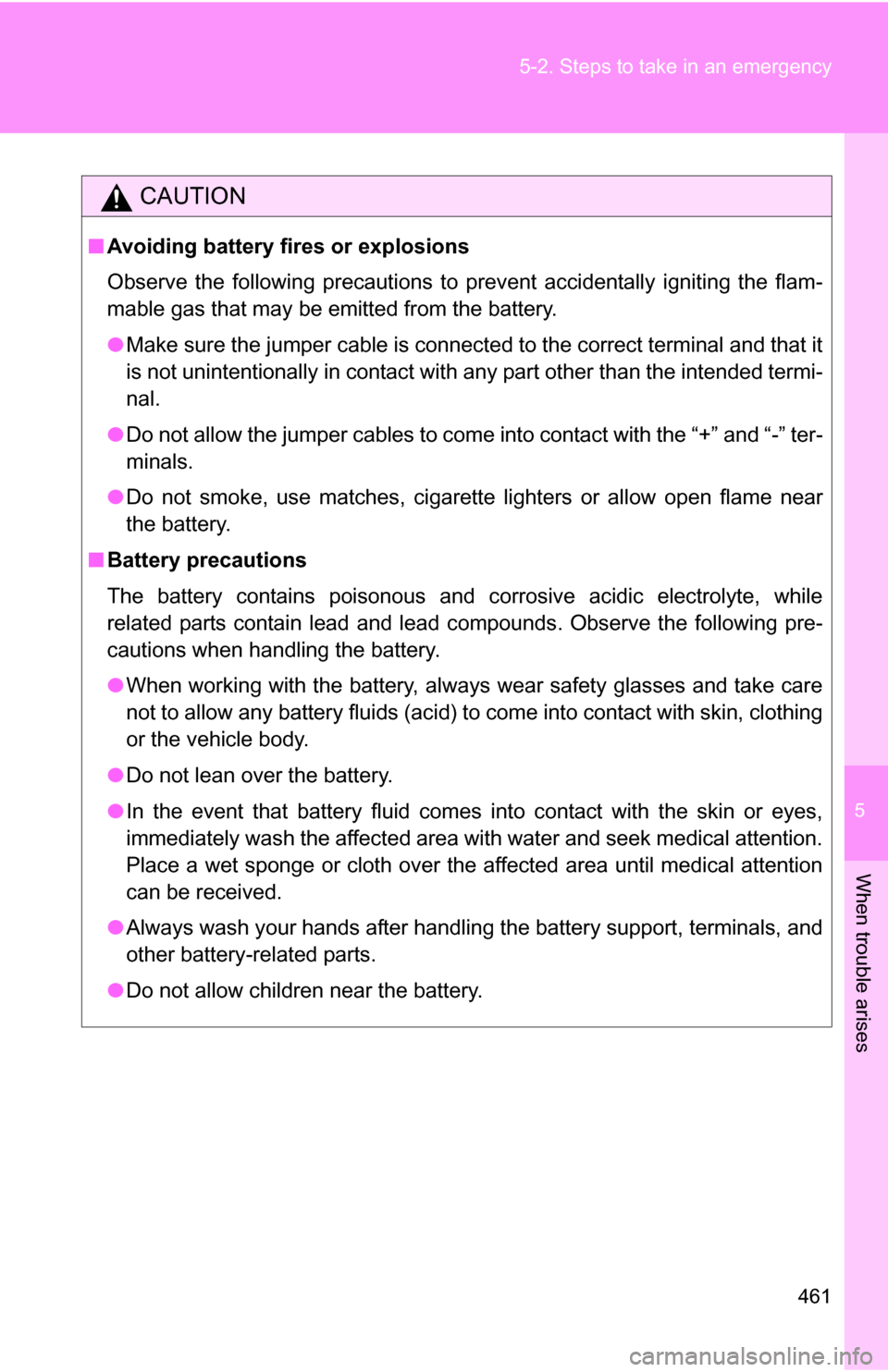
5
When trouble arises
461
5-2. Steps to take in an emergency
CAUTION
■
Avoiding battery fires or explosions
Observe the following precautions to prevent accidentally igniting the flam-
mable gas that may be emitted from the battery.
●Make sure the jumper cable is connected to the correct terminal and that it
is not unintentionally in contact with any part other than the intended termi-
nal.
● Do not allow the jumper cables to come into contact with the “+” and “-” ter-
minals.
● Do not smoke, use matches, cigarette lighters or allow open flame near
the battery.
■ Battery precautions
The battery contains poisonous and corrosive acidic electrolyte, while
related parts contain lead and lead compounds. Observe the following pre-
cautions when handling the battery.
●When working with the battery, always wear safety glasses and take care
not to allow any battery fluids (acid) to come into contact with skin, clothing
or the vehicle body.
● Do not lean over the battery.
● In the event that battery fluid comes into contact with the skin or eyes,
immediately wash the affected area with water and seek medical attention.
Place a wet sponge or cloth over the affected area until medical attention
can be received.
● Always wash your hands after handling the battery support, terminals, and
other battery-related parts.
● Do not allow children near the battery.
Page 476 of 520
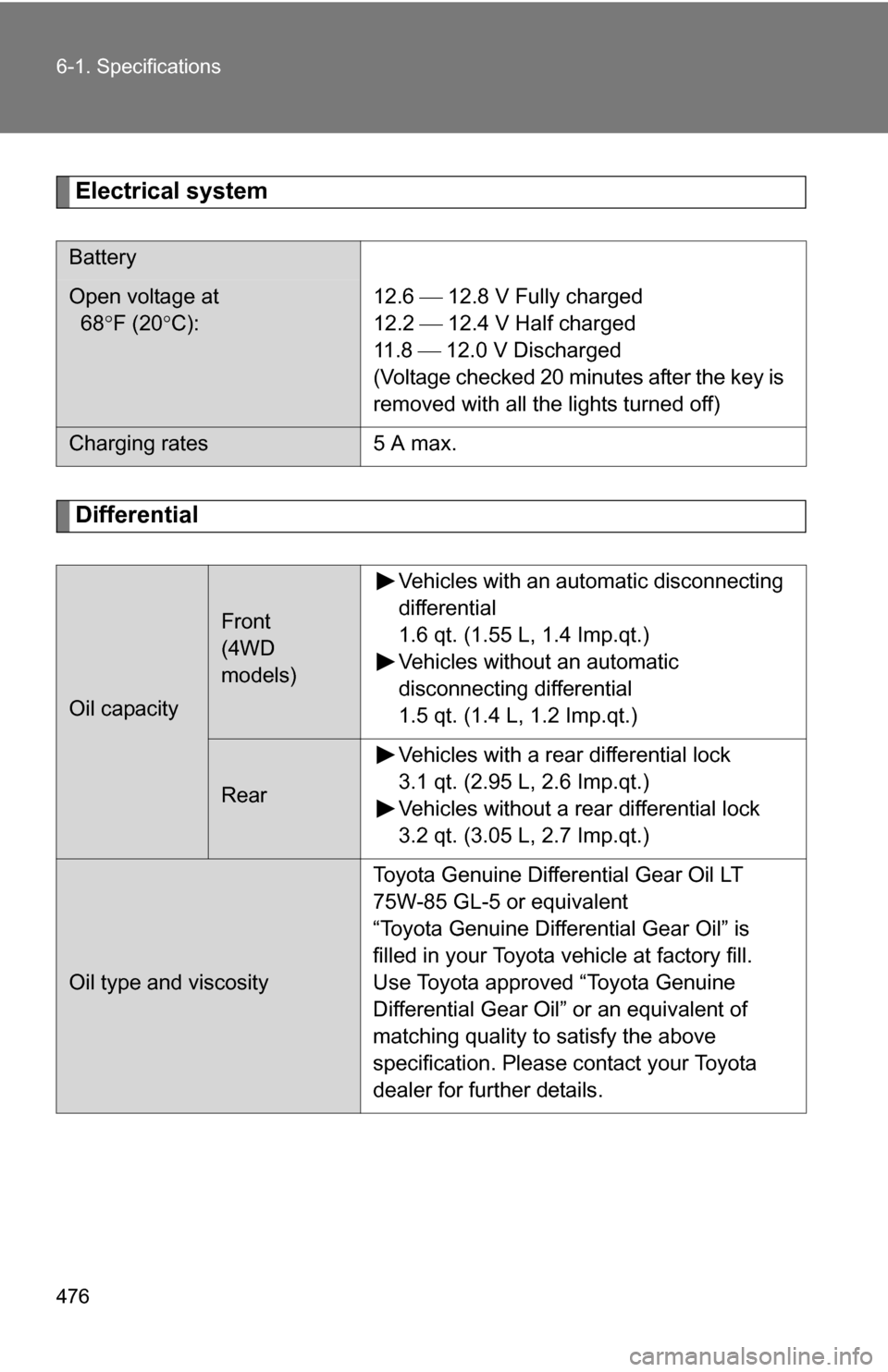
476 6-1. Specifications
Electrical system
Differential
Battery
Open voltage at
68F (20 C):12.6 12.8 V Fully charged
12.2 12.4 V Half charged
11 . 8 12.0 V Discharged
(Voltage checked 20 minutes after the key is
removed with all the lights turned off)
Charging rates5 A max.
Oil capacity
Front
(4WD
models) Vehicles with an automatic disconnecting
differential
1.6 qt. (1.55 L, 1.4 Imp.qt.)
Vehicles without an automatic
disconnecting differential
1.5 qt. (1.4 L, 1.2 Imp.qt.)
Rear
Vehicles with a rear differential lock
3.1 qt. (2.95 L, 2.6 Imp.qt.)
Vehicles without a rear differential lock
3.2 qt. (3.05 L, 2.7 Imp.qt.)
Oil type and viscosity Toyota Genuine Differential Gear Oil LT
75W-85 GL-5 or equivalent
“Toyota Genuine Differential Gear Oil” is
filled in your Toyota vehicle at factory fill.
Use Toyota approved “Toyota Genuine
Differential Gear Oil” or an equivalent of
matching quality to satisfy the above
specification. Please contact your Toyota
dealer for further details.
Page 480 of 520
480 6-1. Specifications
Light bulbs
A: HB3 halogen bulbs
B: H11 halogen bulbs
C: HB4 halogen bulbs
D: Wedge base bulbs (amber)
E: Single end bulbs
F: Wedge base bulbs (clear)
G: Double end bulbs
Light BulbsBulb No.WTy p e
ExteriorHeadlights (high beam) 9005 60 A
Headlights (low beam) — 55 B
Front fog lights 9006 51 C
Parking and front side
marker lights
2827 5 D
Front turn signal lights 1156NA 27 E
Rear turn signal lights — 21 D
Back-up lights 921 16 F
License plate lights 168 5 F
High mounted stoplight 921 16 F
Interior Interior light — 8 G
Personal lights — 5 F
Vanity lights — 3 G
Door courtesy lights — 3.8 F
Glove box light — 1.2 F
Luggage compartment
light
—8 G
Running board lights — 3.8 F
Page 481 of 520
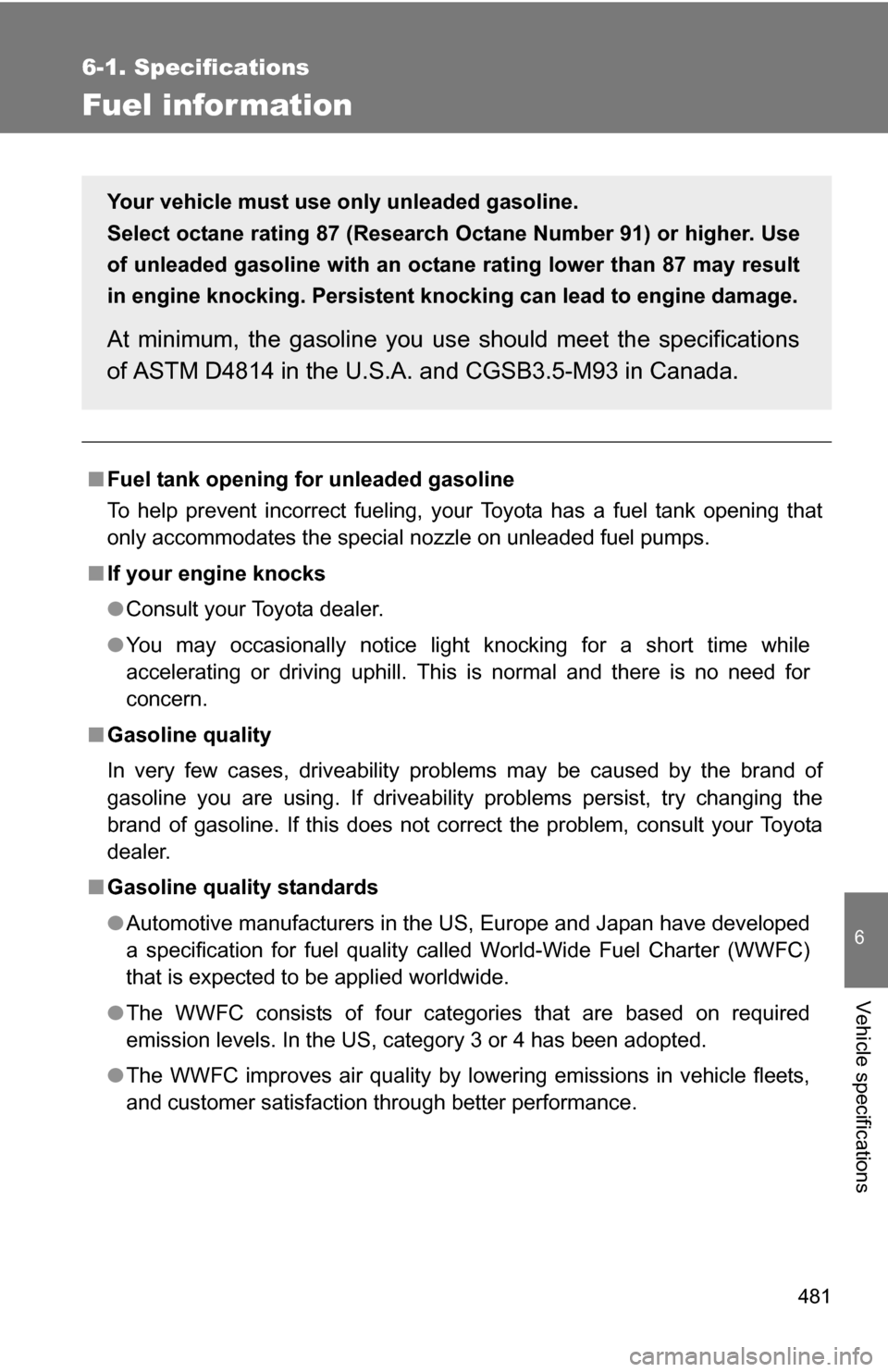
481
6-1. Specifications
6
Vehicle specifications
Fuel infor mation
■Fuel tank opening fo r unleaded gasoline
To help prevent incorrect fueling, your Toyota has a fuel tank opening that
only accommodates the special nozzle on unleaded fuel pumps.
■ If your engine knocks
●Consult your Toyota dealer.
● You may occasionally notice light knocking for a short time while
accelerating or driving uphill. This is normal and there is no need for
concern.
■ Gasoline quality
In very few cases, driveability problems may be caused by the brand of
gasoline you are using. If driveability problems persist, try changing the
brand of gasoline. If this does not correct the problem, consult your Toyota
dealer.
■ Gasoline quality standards
●Automotive manufacturers in the US, Europe and Japan have developed
a specification for fuel quality called World-Wide Fuel Charter (WWFC)
that is expected to be applied worldwide.
● The WWFC consists of four categories that are based on required
emission levels. In the US, category 3 or 4 has been adopted.
● The WWFC improves air quality by lowering emissions in vehicle fleets,
and customer satisfaction through better performance.
Your vehicle must use only unleaded gasoline.
Select octane rating 87 (Research Octane Number 91) or higher. Use
of unleaded gasoline with an octane rating lower than 87 may result
in engine knocking. Persistent kno cking can lead to engine damage.
At minimum, the gasoline you use should meet the specifications
of ASTM D4814 in the U.S.A. and CGSB3.5-M93 in Canada.
Page 492 of 520
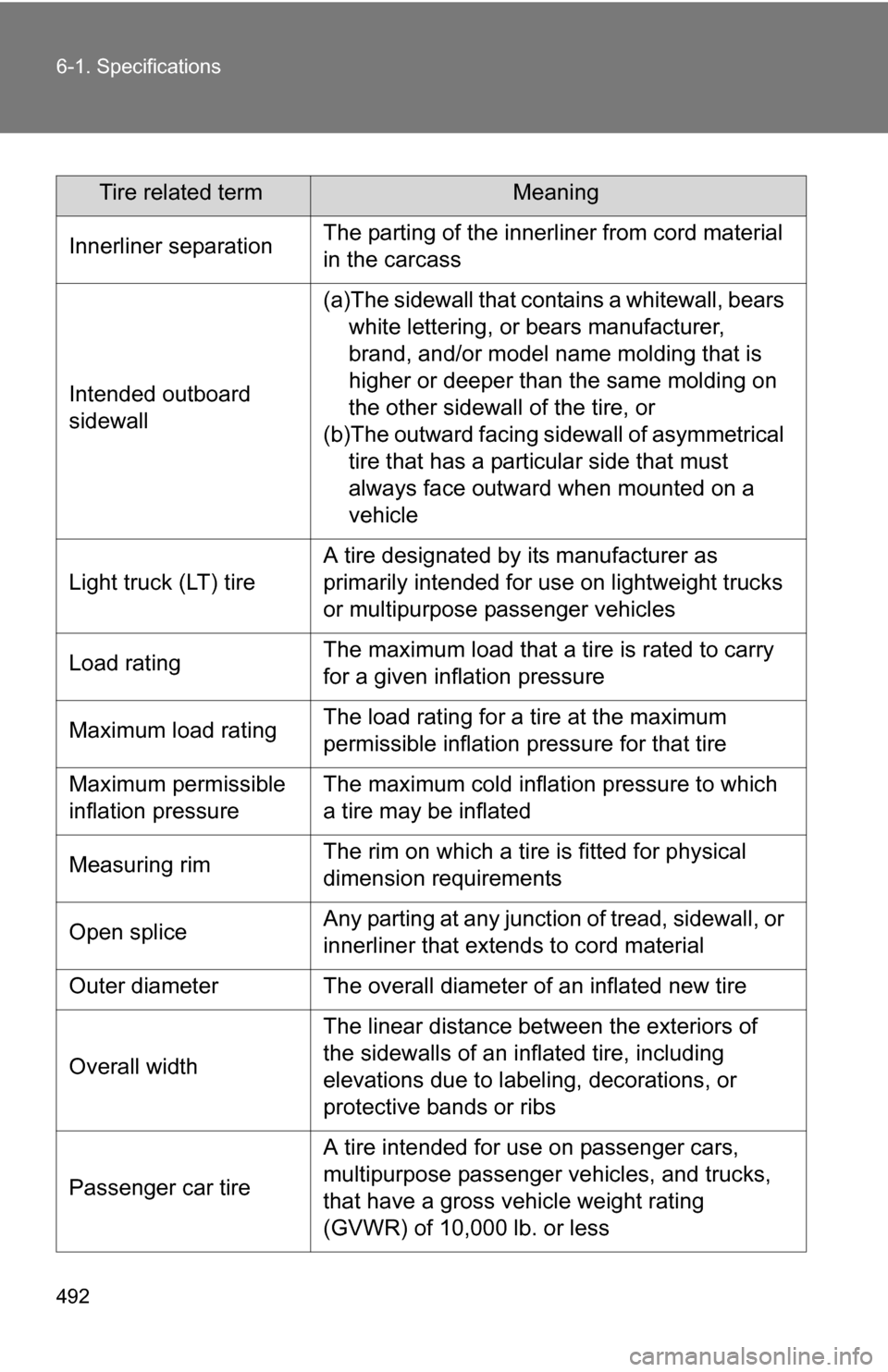
492 6-1. Specifications
Tire related termMeaning
Innerliner separationThe parting of the innerliner from cord material
in the carcass
Intended outboard
sidewall
(a)The sidewall that contains a whitewall, bears white lettering, or bears manufacturer,
brand, and/or model name molding that is
higher or deeper than the same molding on
the other sidewall of the tire, or
(b)The outward facing sidewall of asymmetrical tire that has a particular side that must
always face outward when mounted on a
vehicle
Light truck (LT) tire
A tire designated by its manufacturer as
primarily intended for use on lightweight trucks
or multipurpose passenger vehicles
Load ratingThe maximum load that a tire is rated to carry
for a given inflation pressure
Maximum load ratingThe load rating for a tire at the maximum
permissible inflation pressure for that tire
Maximum permissible
inflation pressureThe maximum cold inflation pressure to which
a tire may be inflated
Measuring rimThe rim on which a tire is fitted for physical
dimension requirements
Open spliceAny parting at any junction of tread, sidewall, or
innerliner that extends to cord material
Outer diameterThe overall diameter of an inflated new tire
Overall width
The linear distance between the exteriors of
the sidewalls of an inflated tire, including
elevations due to labeling, decorations, or
protective bands or ribs
Passenger car tire
A tire intended for use on passenger cars,
multipurpose passenger vehicles, and trucks,
that have a gross vehicle weight rating
(GVWR) of 10,000 lb. or less
Page 496 of 520
496 6-2. Customization
Door lock
(P. 33) Speed-detecting auto-
matic door lock function
OFF ON
Opening driver’s door
unlocks all doors. OFF ON
Shifting gears to “P”
unlocks all doors. OFF ON
Shifting gears to posi-
tion other than “P” locks
all doors. ON OFF
Unlocking using a key Driver’s door
unlocked in
one step, all
doors
unlocked in
two stepsAll doors
unlocked in
one step
Power back
window
( P. 79) Mechanical key linked
operation (close)
ON OFF
Mechanical key linked
operation (open) ON OFF
Wireless remote control
linked operation (open) Push and holdPush twice
One short push OFF
Automatic
light control
system
( P. 158) Light sensor sensitivity Level 3 Level 1 to 5
Daytime running light
system
ON OFF
Time elapsed before
headlights automati-
cally turn off after doors
are closed 30 seconds0 seconds
60 seconds
90 seconds
Time period until lights
turn on 0.1 seconds 1.0 second
ItemFunctionDefault settingCustomized
setting